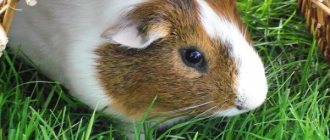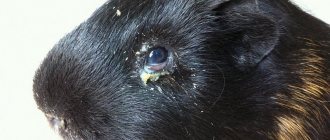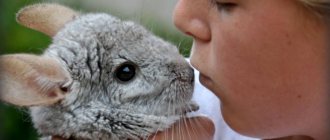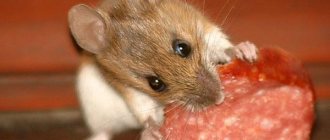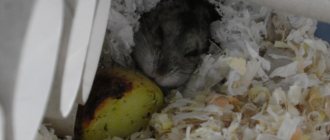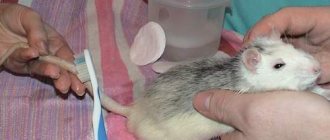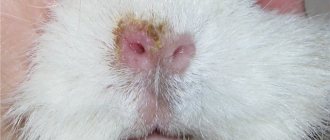What diseases of domestic rats are dangerous for these animals. Pets come in all different shapes and sizes. Among them are rodents: hamsters, chinchillas and, of course, rats. Caring for rats requires not just ordinary knowledge of keeping them, but also specific conditions for keeping and caring for them. It is important to consider the cage, food, bedding and many other factors that affect the health and immunity of the animal.
It is important not to diagnose and treat yourself ; this will have a bad effect on the health of the rodent, which is already susceptible to disease. Traditional medicine is not the best way to rid your pet of pathology and abnormalities. It is better to entrust this matter to a professional veterinarian who knows how to treat the disease. At the veterinary office, an experienced expert is ready to respond to a call within an hour at a time that the owner chooses. The veterinarian also has all the necessary tools and papers with him, which means he will conduct diagnostics and tests upon arrival .
In this article we will look at the basic methods of keeping rats, diagnostics, rat diseases and their treatment.
Diseases of rats and mice: a list of obvious ones
Contrary to the myth about their vitality, ornamental animals are not in good health. Typical mistakes in keeping and breeding shorten the already short life of a pet.
What diseases of rats and mice are diagnosed:
- diseases of the ears, eyes;
- infectious pathologies;
- injuries of varying severity and location;
- tumors (benign, malignant);
- disruption of internal organs.
Fact! Rodents do not suffer from rabies, although theoretically it cannot be ruled out that they can become carriers of a dangerous pathology. Such cases are rare.
HIV infection is practically not diagnosed in rodents. There are frequent cases of the formation of malignant neoplasms, and the pituitary gland is the first to be affected.
How to understand that your pet is sick
There are several signs that, even before an accurate diagnosis is made, indicate the presence of the disease in decorative rats. The most common painful symptoms in rodents include:
- deterioration of mood, lethargy, apathy;
- weakened state, the pet prefers to sit in one place because it has difficulty moving around the cage;
- dulling of fur;
- the appearance of bald patches;
- decreased or complete lack of appetite;
- red nasal discharge – porphyrin;
- sneezing, coughing;
- drowsiness;
- unreasonable aggression, anxiety;
- change in stool;
- impaired coordination of movements.
If any of the listed signs appear, it is necessary to take the animal to the veterinary clinic as soon as possible. Delay in treatment can be fatal for the rat.
Pet pathologies
Rats and mice living at home do not like drafts and are susceptible to respiratory diseases. Initial grunting, snoring, and wheezing quickly develop into pneumonia with a high risk of death.
Decorative mice suffer from a viral infection - mousepox, which ends in death in 80-90% of cases.
Infectious diseases of rats and mice:
- Tuberculosis.
- Arachnoses (parasites).
- Pneumonia, ARVI.
- Mycoplasmosis.
The constant companions of wild rodents are skin parasites (ticks, fleas, lice eaters) and ringworm. Pets are also sensitive to them, but diseases appear if they are poorly maintained.
Tumors of various origins, problems with teeth, gums, and urolithiasis are diagnosed as non-infectious diseases. Older rats suffer from cardio-renal failure and obesity, which is not surprising given a sedentary, well-fed lifestyle. This manifests itself in dysfunction of the respiratory system, water retention and swelling. You need to pay attention to the gastrointestinal tract, especially with improper feeding.
What are the most common diseases of domestic rats?
Decorative rats, like any other animals, are susceptible to many diseases. However, some pathologies are most common in small rodents. Such diseases include:
- Oncology . Rats are prone to developing tumors. Most benign tumors are removed surgically. Malignant neoplasms, unfortunately, cannot be treated.
- Colds . Decorative rats are very sensitive to the slightest changes in environmental conditions. A slight draft or a drop in temperature of a few degrees can trigger a cold.
- Infections of viral, fungal and bacterial nature . The immunity of rats is quite weak, so when encountering pathogenic microorganisms, the animal’s body offers practically no resistance.
- Parasitic diseases . Rodents are subject to invasion by both external (ticks, fleas) and internal parasites (helminths).
Many diseases of decorative rats develop against the background of improper keeping of furry rats. For the well-being of rodents, care must be taken to maintain a comfortable microclimate and cleanliness in the cage.
What diseases do rats and mice carry?
Decorative pets can “share” infectious pathologies. The list of potentially dangerous to humans includes:
- plague, typhus;
- "rat bite" (sodoku);
- pneumonia;
- toxoplasmosis, listeriosis;
- tularemia, leptospirosis;
- rickettsiosis, toxocariasis;
- rabies, hemorrhagic fever.
The list of diseases from rats and mice will continue with fungal diseases (ringworm), pasteurellosis, and lymphocytic choriomeningitis. Diseases are transmitted by airborne droplets, through skin lesions and bites. Domestic rodents are less dangerous, but you should still not have close contact with them, kiss them, or eat from the same plate.
Leptospirosis in rats
Leptospirosis is a bacterial disease that affects people and animals. Caused by bacteria of the genus Leptospira. People experience great variability in symptoms, some of which may be mistaken for other diseases. Some infected patients have no symptoms at all.
Left untreated, leptospirosis can lead to kidney damage, meningitis (inflammation of the lining of the brain and spinal cord), liver failure, respiratory distress, and even death.
The bacteria that causes leptospirosis is spread in the urine of infected animals. Urine can get into water or soil, and bacteria can survive there for weeks or even months. Many species of wild and domestic animals are carriers of leptospirosis. Carriers can be (not a definitive list): cattle, pigs, horses, dogs, rodents, wild animals.
Infected animals may not show clinical signs. Infected animals may continue to shed bacteria into the environment continuously or intermittently for months or even years.
People can become infected through:
- Contact with urine (or other body fluids excluding saliva) from infected animals
- Contact with water, soil or food contaminated with urine from infected animals
Bacteria can enter the body through the skin or mucous membranes (eyes, nose or mouth), especially if the skin is broken. Drinking contaminated water can also cause infection. Outbreaks of leptospirosis are usually caused by drinking contaminated water, such as after a flood. Person-to-person transmission is rare.
What does a sick rodent look like?
A breeder of rats and mice should be aware of a number of signs that may indicate ill health in a pet.
Suspicious symptoms:
- change in behavior (apathy, aggression);
- discharge from the eyes, cloudy cornea, sticky eyelids;
- dull and unkempt fur;
- nasal discharge, mucus, crusts;
- unusual posture, tension.
Diseases of the cardiovascular system are characterized by a lack of air, the rodent falls on its side. Urine will “tell” about kidney diseases; it is cloudy, with impurities, a pungent odor, and discolored. Constant itching, bald spots, and hair loss indicate skin parasites.
All decorative rodents have problems with teeth. In nature, they constantly chew on objects, grinding down their teeth. Pets at home do not have the opportunity to move freely and choose. If the owner does not take care, there is a risk of excessive growth of the incisors, damage to the soft tissues of the skull and bones.
What else do rats get sick with?
The list of diseases of decorative rats can be continued for quite a long time, since these rodents by nature have rather poor health. In addition to the diseases listed above, rats most often suffer from the following pathologies:
- Pododermatitis . In simple words - corns. Appear when kept on rough bedding. Risk factors also include older age and increased body weight. Complications of the disease include suppuration, which is very painful and subsequently breaks through. To avoid such problems, rats' feet are moisturized with baby cream or oil. It is also recommended to replace the bedding with a softer one, such as paper litter.
- Conjunctivitis . It develops in improper sanitary conditions - when dust and dirt particles get into the eyes, as well as when the eyelids are damaged (for example, scratching). Symptoms of the disease include: swelling of the mucous membranes and skin of the eyelids, drainage from the eyes leading to souring, decreased visual acuity, and lethargy. Treatment is carried out by instilling special eye drops. The drug and dosage are selected by the veterinarian.
- Periodontitis is a dental disease characterized by gradual loosening and loss of incisors. Poor quality nutrition, predominantly liquid foods, leads to the development of pathology. Symptoms of the disease include yellowing and loosening of teeth, bad breath, and red and swollen gums. Treatment consists of removing damaged teeth.
- Vitamin deficiency . It develops against the background of an unbalanced rodent diet, leading to an acute deficiency of vitamins. Characteristic symptoms: lethargy, dullness and hair loss, drowsiness, mood swings. Treatment is carried out by introducing fresh vegetables, fruits and berries into the diet, as well as adding special vitamin complexes to the feeders.
Every rodent owner should have information about diseases of ornamental rats: symptoms and treatment, causes and prevention - issues that need to be studied before purchasing a pet. Early recognition of the disease and timely visit to the veterinary clinic will not only help to avoid complications, but may also save the animal’s life.
Common rodent diseases: symptoms
The following diseases are more common in veterinary practice according to call statistics. Symptoms are not always specific, so the help of a veterinarian is required in any case.
Respiratory diseases
VGB provokes a virus that affects the hematopoietic organs. Hemolytic disease is manifested by symptoms of respiratory failure, bleeding from the mouth, anus, and nose.
Bronchosepticosis is characterized by the appearance of serous-purulent nasal discharge. In the absence of treatment and the addition of bacterial microflora, the disease quickly develops into pneumonia. Symptoms: apathy, insufficient functioning of the cardiovascular system, anorexia, the death of the animal occurs from exhaustion within 1-2 months.
Tuberculosis is suspected if there are enlarged lymph nodes, skin ulcers, or a cough with the release of a specific secretion.
With mycoplasmosis, red, dried crusts appear on the nose, a consequence of the formation of porphyrin. The disease often provokes respiratory pathologies and is characterized by wheezing that lasts more than 1 day. Symptoms: whistling, snoring, sneezing. Breathing is difficult; the intercostal muscles are activated during breathing. Rats and mice die if left untreated.
Pasteurellosis is a bacterial infection that affects the respiratory system. A cough, tachycardia, and rapid pulse develop. A purulent secretion forms in the nasal passages.
Aspergillosis develops due to the penetration of fungal spores into the lungs. The mycelium grows, specific nodules and foci of necrosis are formed. Breathing is difficult, the cardiovascular system is malfunctioning.
Symptoms of rhinitis do not always indicate infectious diseases. Mucopurulent discharge, snoring, and sneezing may indicate neoplasms of various locations, allergies, pulmonary edema and pulmonary insufficiency.
Heart diseases
Rats and mice suffer from arrhythmia, cardiomyopathy, and dysfunction of the heart valves. Visually at home, it is almost impossible to determine CVS pathologies based on symptoms, so they are diagnosed in most cases posthumously. Heart abnormalities are caused by respiratory diseases, systemic pathologies and tumors.
Characteristic features:
- lethargy, apathy, anorexia;
- body position – head tilted up to facilitate breathing;
- the rodent is almost constantly asleep;
- swelling in the joints of the paws not associated with damage;
- dry heart cough.
The urine becomes dark, smells bad, and is rich. During the examination, cyanosis and coldness of the mucous membranes and skin of the peripheral parts of the body are noted. A timely consultation with a veterinarian will help alleviate the pet’s condition and prevent death.
Urological pathologies
Nephropathy is diagnosed in aged rats and mice. Characterized by enlarged kidneys, protein in the urine increases. KSD is a consequence of improper feeding, the rodent tries to urinate for a long time, the urge is empty, the urine is dark and mixed with blood. With cystitis of an infectious or traumatic nature, there is nervousness, a forced, unnatural (hunched) posture, urine leaks in small portions, and the process is accompanied by anxiety and squeaking.
Digestive diseases
Infectious stomatitis is rarely diagnosed; it can be detected by the “wet face” symptom. Ulcers and erosions appear in the oral cavity; the area around the nose and mouth is always moist due to salivation. They refuse to eat rats and mice; the pain from the damaged mucous membrane does not allow them.
The inability to constantly grind the incisors provokes their excessive growth. They injure soft tissues, sometimes they simply “pierce” the skull, making eating difficult or impossible.
Gastrointestinal diseases:
- Sometimes due to stress, lethargy, vomiting, constipation or diarrhea, and anorexia are observed.
- Infections, foreign objects, and sudden changes in feeding negatively affect the gastrointestinal tract in mice and rats.
- In case of poisoning there are: shortness of breath, diarrhea, porphyrin, loss of coordination, convulsions, stress, forced posture.
- Under stress, stool softens and the smell of feces is unpleasant. Usually does not require treatment, it is enough to eliminate the source of concern.
Dangerous infectious diseases: tularemia, salmonellosis, pasteurellosis, VGB, “wet tail”, passalurosis.
Ornamental rodents should not be given food from the table; smoked foods, fried foods, marinades, and sweets are dangerous. Vegetables cause stool liquefaction, diarrhea occurs from dairy products, and a sharp change in diet leads to changes in the functioning of the gastrointestinal tract.
Rats and mice love to sneak inedible objects (plastic, rope, fabric, etc.) into the house. If they enter the intestines, a blockage occurs; treatment is only surgical.
Pathologies of the reproductive organs
In female domestic rodents, inflammation of the reproductive organs, pyometra, is common. In males there are neoplasms of the testes, in “ladies” there are malignant formations of the mammary glands, internal organs, and ovarian cysts. In case of miscarriage, listeriosis, trauma are suspected, and attention is paid to age or frequent childbirth.
Spirochetosis can be suspected by serous-mucopurulent inflammation and swelling of the genital organs; spirochetes colonize the skin on the back, eyelids, anus, causing ulcers.
Diseases of the central nervous system
Neurological symptoms in rats and mice occur due to injuries and infections. Diagnosed: lymphocytic choriomeningitis, Aujeszky's disease, encephalomyelitis, plague, rabies (rare). Tumors of the central nervous system and neuroses in rats are practically not identified. The latter occur due to violation of the conditions of detention, crowding, lack of attention, constant movement of the cage or internal contents, and anxiety.
The inattentive attitude of the breeder is fraught with injuries of various origins and symptoms; “painful heel” or pododermatitis occurs when the quality of the floor in the cage is poor, the pet is overweight and has minimal movement.
Lymphocytic choriomeningitis
Lymphocytic choriomeningitis (LCM) is an infectious viral disease. Transmitted by rodents, the causative agent is lymphocytic choriomeningitis virus (LCMV), a member of the family Arenaviridae, which was originally isolated in 1933.
The main host of the LCM virus is the common house mouse, Mus musculus. Infection in house mouse populations may vary depending on geographic location. House mice can transmit the virus throughout their lives without showing any signs of illness. Other rodents, such as hamsters, are not natural reservoirs but can become infected with lymphocytic choriomeningitis virus LCM from wild mice at a breeder, pet store, or home. Humans are most likely to become infected with lymphocytic choriomeningitis virus from house mice, but there is also evidence of infection from other domestic rodents.
Lymphocytic choriomeningitis virus disease has been reported in Europe, America, Australia and Japan and can occur where infected rodents are found.
Lymphocytic choriomeningitis most often presents with neurological symptoms, as the name suggests, although asymptomatic infection or mild fever is the more common clinical presentation.
In infected people, the first symptoms usually appear 8 to 13 days after exposure to the virus. The initial phase can last up to a week and usually begins with one or more symptoms: fever, malaise, lack of appetite, muscle pain, headache, nausea and vomiting. Other symptoms that appear less frequently include sore throat, cough, joint pain, chest pain, testicular pain, and parotid gland pain. In addition, pregnancy-associated infection is associated with congenital hydrocephalus, chorioretinitis, and mental retardation.
Pathology of the skin and its appendages
Skin diseases are caused by a lack of vitamins and minerals, allergies, diseases of the digestive system, fungal infections and ectoparasites. The most striking sign of a disease of the skin and its appendages is baldness.
An animal may lose fur as a result of:
- stress;
- nutrient deficiency;
- fungal infection (ringworm);
- helminth infections;
- long course of cancer;
- and parasitism of mites (skin and lice mites);
- as well as fleas and lice.
These diseases are characterized by itching, deterioration of hair quality and hair loss. At the same time, the animal scratches the skin until there are wounds into which bacteria can penetrate.
Prevention
To reduce the likelihood of a cold in your pet rat, follow these recommendations:
- The pet's cage or house should be kept in a warm place, well protected from drafts.
- It is necessary to monitor air humidity and adjust it if significant deviations occur.
- Avoid walking during the cold season.
- If there are drafts in the room, do not let the rat fall on the floor.
- Carefully monitor nutritional balance and food quality.
- As a preventative measure, sprouted cereal seeds (wheat, oats) should be given in the autumn-winter period.
- Avoid contact of the animal with sick people or other pets.
Remember that proper nutrition and optimal living conditions help strengthen the immune system. This is the key to good health for the rat, since its body will be able to cope with most infections on its own.
The health of the rodent is primarily the responsibility of the owner. It is important not only to create good living conditions for the “little friend”, but also to carefully monitor his condition. If the slightest sign of illness occurs, you need to show it to a competent specialist.
Other diseases
Mouse pox or ectromelia
This pathology affects rats, mice, and less often other rodents. The disease is viral and affects animals that are weakened, for example as a result of severe stress. Rats and mice that are kept in cramped conditions are more likely to get sick.
The main signs of the disease are:
- swelling of the limbs;
- necrosis and ulceration of the epithelium of the skin of the extremities, then foci of gangrene appear;
- the appearance of pustular formations in the tail area (abscesses, boils).
At autopsy, animals are found to have serious pathologies of the liver (cirrhosis, dystrophy) and spleen. There is no treatment for this disease; mortality is 100% of affected animals. Therefore, when diagnosing this disease in pets, it is recommended to euthanize them.
Ear diseases
Otitis media is sometimes reported in rats. It is characterized by torticollis, the discharge of pus from the ear. The owner may feel an unpleasant odor from the animal’s ear even before discharge appears. At the same time, the pet rubs its ears vigorously and regularly.
Eye diseases
Most often this is conjunctivitis. This disease can be caused by debris getting into the pet's eye, injury during a fight, and infection. The pathology is characterized by swelling of the eyelids, redness of the mucous lining of the eye, lacrimation, the appearance of pus and sticking of the eyelids.
Digestive disease
Oral diseases
This group includes infectious stomatitis (wet muzzle) and excessive tooth growth. Infectious stomatitis rarely occurs in rats.
However, when:
- ulceration of the mucous membrane of the oral cavity, tongue;
- pet's refusal to eat;
- constantly wet face.
It's worth thinking about this illness. If there is a lack of wooden objects for grinding down the incisors, these teeth in rats can grow to large sizes, injure the tongue, cause hypersalivation and refusal to eat. Anomalies of molars have not been recorded in small rodents.
Gastrointestinal diseases
These pathologies are characterized by diarrhea, less often constipation, lethargy of the animal, loss of appetite, and sometimes vomiting.
They can be called:
- poisoning;
- stress;
- infections (bacterial, viral, helminthiases);
- food that irritates the mucous lining of the stomach and intestines;
- foreign objects;
- individual food intolerance;
- rich or inappropriate food;
- change of diet (sharp and radical);
- drug treatment (primarily antibiotics, sulfonamides, chemotherapy drugs);
- oncological diseases of the gastrointestinal tract.
Poisoning
In case of poisoning in a small rodent, in addition to diarrhea, the following are observed: porphyrin secretions, apathy and refusal to eat, a hunched posture, and shortness of breath. There may be seizures and incoordination.
Impact of stressors
Under various stresses, a rat or mouse can excrete very soft and light-colored feces with a clearly distinguishable and unpleasant odor. This is a temporary disorder and does not require treatment.
Infectious diseases accompanied by abdominal symptoms
Many infectious diseases occur with stool disturbances, general weakness of the animal and its refusal to eat. This includes coccidiosis (intracellular parasitism of coccidia), and viral diseases and helminthiases, and bacterial infections.
For example, tularemia is accompanied by fever and vomiting.
Salmonellosis (paratyphoid) is characterized by bloating, strong grumbling, loose stools with a specific and extremely unpleasant odor.
Pasteurellosis in later stages is accompanied by diarrhea, loss of appetite, and swelling in the head and neck area.
VGB can occur with diarrhea and other unpleasant symptoms. Death occurs in 90% of cases.
Passalurosis occurs with symptoms of catarrh of the large intestine, stool disturbance, and itching in the anus and tail.
Wet tail is an infectious disease that occurs with stool that is liquid like water (due to which the fur in the anus area is constantly wet), loss of appetite, and irritability of the animal.
Food that irritates the animal's intestines
Rats should not receive fatty or fried foods from the master's table. You should not offer them sweets or marinades. All these foods can lead to enteritis and diarrhea.
Foreign objects
Small foreign objects can irritate the mucous lining of the digestive tract, large ones, as well as polyethylene, can cause constipation and colitis. Treatment is surgical.
Food intolerance
Rats can be lactose intolerant and will react with diarrhea to any dairy product. Sometimes laxative foods (beets, prunes) cause severe dilution of feces in these animals.
Rich food
Excessive variety of diet during one day or too large portions of food will inevitably lead to disruption of the stomach and intestines.
Changing your diet
Sudden changes in food can cause diarrhea in rats and mice. There is no need to feed your pet a dozen different foods at once. This will inevitably cause gastroenteritis.
Oncological diseases
Tumors of the gastrointestinal tract lead to stool disturbances, the appearance of mucus and blood in the stool, loss of appetite, abdominal pain, and emaciation of the pet.
Rectal prolapse
The disease is not typical for small rodents, but sometimes occurs. The prolapsed part of the intestine is visible visually and requires reduction. It is better to take your pet to a doctor for these purposes.
